May 31 2019 – Volume 21, Issue 4
In This Issue
Flanigan’s EcoLogic: Sailing to Catalina!
North American Carbon World 2019
Aspire 2019
Tree-Planting Campaigns: Muvuca!
Banning Polystyrene
Plastic Solutions
Reader Comment: Pat Conlon on Recycling
Big Wind
EcoMotion Updates
Take the Quiz
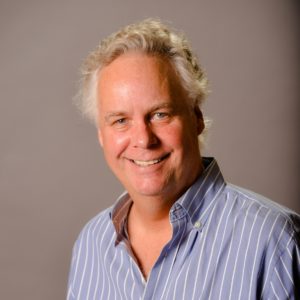
Flanigan’s EcoLogic: Sailing to Catalina!
What a feeling to be leaving it all behind… pushing off from the dock, winding our way out of Marina Del Rey, past the breakwater to open water!
Sailing is a favorite. It has been for years, ever since I got over being terrorized by Gary in Cold Spring Harbor as a child. A seasoned sailor, in a high wind he’d make us newbies sit way to lee, terrorized by the thought of capsizing. Since then, I’ve capsized many a time, crewed on many a sailboat, loved the independence of my Laser dearly, and have chartered boats as far away as the Greek Isles.
This trip to Santa Catalina Island was extra-special! I was the first mate to my dear friend and our captain, Peter Rumsey. I loved being part of his family for four days, joining Anna and Julien and his gal Kat. Sound and well-stocked was our good ship. Sunshine every day and while our winds were moderate, the massive swells made very real the power of the Pacific. Our 40-foot Beneteau plied these seas with great respect.
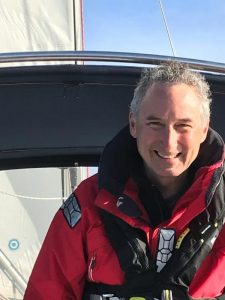
Peter Rumsey
For the past 21 years, I have lived in Los Angeles. Much less than half the time you can see Catalina. It’s only 14 miles away offshore but is most often occluded by haze and weather. Two Harbors is 21 miles due south of Marina Del Rey. Seven miles to Palos Verdes, then 14 miles to Catalina. We’re extra careful crossing the shipping channel. Our ship is equipped with GPS, sonar, and communications, but I’m still comforted by the fact that we could see the island the entire time.
Headed for Two Harbors, also known as “the isthmus.” It’s the second largest city on Catalina Island, an outpost inhabited by 298 hearty souls who’ve blown off civilization as we know it in on the mainland to live the island life. They’re serious… even finding the bustling city of Avalon, with a population of 3,764, too intense. Life in Two Harbors is slow and steady; its unique breed connected only to the mainland by ferries and boaters like us.
Four days and three nights of great food and drink. We swim in frigid waters, eat, drink, sail, and sing. We meet Brenda and Richard from Washington whose home burned. Instead of rebuilding, they invested their insurance in a boat and are now circumnavigating the world, stopping only for Brenda to take on nursing jobs to recharge the coffers. Their boat is ocean ready… drop the sails, batten the hatches, and wait it out like a cork floating on a choppy sea they say.

Catalina is one of LA’s finest getaways. An hour-long ferry from Long Beach, Newport, or Dana Point can transform one’s venue… from the bustle of L.A. to Catalina’s Mediterranean feel. I peel off from the crew to take a long hike, winding in and out of the island’s wild coastline, inlet after inlet heading north… peering down on youth camps where many inner-city kids have their first experiences in nature. I spot squads of colorful kayaks from my trailhead perch and think about the cool factor of homes that I see that are only accessible by water.
Like any trip, there’s only one thing better than going way, and that’s getting home. But we all know how quickly a trip’s rich experience fades away. Suddenly everything changes; there’s a sad release of bonds with fellow sailors. Then a bit of shock therapy, the tranquility of the ocean traded in for something really raw… rush-hour traffic on the 10 freeway. But the memories live on, like relish to a full life.
Quote of the Week
“If the environmental movement is going to survive, it’s going to have to speak Spanish, it’s going to have to speak Chinese.”
California Insurance Commissioner Ricardo Lara
Speaking at the NACW 2019 Conference
North American Carbon World 2019
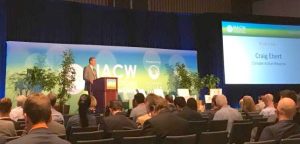
Craig Ebert speaking at NACW
Hats off to Craig Ebert and his team at Climate Action Reserve. The Reserve not only verifies hundreds of thousands of carbon offsets each year, but also puts on an important annual conference. Navigating America’s Carbon World – the 17th annual conference – is a testament to the Reserve’s resolve and business model, and the need for verified offsets to support Emissions Trading Schemes (ETS) to reach national climate protection commitments.
Four hundred strong gathered at the Intercontinental Hotel in Los Angeles, gorgeous conference facilities in the brand-new hotel in the tallest building west of the Mississippi. We’re here to talk climate and carbon. Craig kicks off the conference with the clear message that, “Humanity is quickly running out of time. Time and time again we hear this message. Perhaps we are becoming numb to it. But it’s real and alarming. The fourth U.S. National Assessment came out last year. It found that the climate is changing faster than at any point in history.” Without concerted action, Earth could experience an 8 degree temperature rise.
What’s new and hopeful? Craig noted youth protests: “Our youth is fed up about power elite not seriously addressing the issue. Kids are gluing themselves to buildings and bus. They are boycotting school on Fridays. What’s different? Youth is speaking with a strong voice.”
In reality, there’s been lots of progress thanks to many attending the conference. California’s AB 398 extended California’s cap and trade policy; now Mexico is implementing cap and trade. But where are we collectively? There is no rulebook yet for Paris Agreement. And even if everyone complies, which is questionable, Ebert believes that our global society will still be a far cry from 1.5 degrees temperature rise deemed the maximum allowable without catastrophic consequences.
The World Bank reports on how carbon pricing will likely play a role in meeting the goals from Paris. Many nations are planning to trade (joint implementation) to meet their goals. As of 2017, there were 51 different carbon pricing structures – trading systems, carbon taxes, etc. — worth $82 billion. “But it’s a far cry from where we need to be. Of the Fortune 500, only 109 companies have made a commitment.” Ebert concludes that, “We must do more to accelerate climate action. There is no choice.” Later we learn that the level of investment required for a sustainable future is on the order of $80 trillion.
This year it was a pleasure to speak at the conference. I engage with fellow speakers and sponsors at a Disney Concert Hall reception. I chat with a Fivepoint developer digging for more offsets for the 21,000-unit Newhall Ranch development that has pledged to be net zero carbon. I’d been asked to speak about corporate impacts; fellow panelists were from Dow Chemical and Salesforce. My remarks focused on three co-benefits of large solar and storage projects: Profit Centers, Employee Attraction and Retention, and Increased Productivity. While the companies that EcoMotion works for are sensitive to climate change, we bring them solutions that mitigate climate threats and that deliver valued co-benefits.
Aspire 2019
 Invited to Aspire 2019, a conference in the heart of the Silicon Valley put on by Bloom Energy for the past five years. This year it was held at the Computer History Museum in Mountain View. I headed to the conference after attending a carbon-free workshop at Bloom’s headquarters and then a Bloom fuel cell factory tour.
Invited to Aspire 2019, a conference in the heart of the Silicon Valley put on by Bloom Energy for the past five years. This year it was held at the Computer History Museum in Mountain View. I headed to the conference after attending a carbon-free workshop at Bloom’s headquarters and then a Bloom fuel cell factory tour.
My first Aspire. Bloom pulls out the stops to put on a good show. Fareed Zakaria, Aspire’s Master of Ceremonies, called the conference “an incredibly heavy diet” of intellectual stimulation. We were convened to address climate change and the pressing need to combat it. Solutions were the order of the day.
Aspire addressed overarching and pressing issues… the clear presence of climate change; the need for multiple solutions for decarbonization. We need to think and act broadly to address mobility emissions, cyber security, international policies and tariffs, and even sustainable wine-making in Napa!
KR Sridhar is Bloom’s founder, Chairman, and CEO. His remarks were poignant: “Never underestimate or bet against innovation.” His innovation… dubbed the “Boom Box,” is the world’s most efficient fuel cell. It’s not carbon-free but Bloom has developed a technology and business proposition that makes sense in many ways. Bloom’s carbon emissions are less than those of most utility grids, and its power costs less… while providing resiliency. When paired with offsets, Bloom provides a carbon-free solution.
The conference focused on how to adapt to climate change and how to move quickly to deploy clean energy technologies, from renewables to fuel cells, and storage. A conference mantra was inclusive: We need renewables; we need low-carbon technologies; we need carbon-free technologies, and we need grid stability and distributed solutions. Sridhar added to this: “We need solutions that we don’t even know.”
An all-star line-up was on hand. Federal Energy Regulatory Commission (FERC) Chairman Neil Chatterjee surprised us all with his candor and concerns about climate change. Zakaria queried him on this given the President’s views on climate change: “How can you get away with it?” Chatterjee stated that he views his purview as including interstate system reliability. New regulations on energy storage can support this. He wants to, “create a regulatory system to enable new technologies to flourish.”
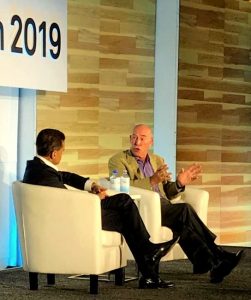
Fareed Zakaria and Michael Mondavi
George Shultz has a heck of a resume, the Former Secretary of Labor and Secretary of Treasury for President Nixon, and then Secretary of State under Ronald Reagan. Along the way he ran Bechtel. At age 98, he impressed us with his wisdom and opinions. He strongly advocates carbon taxes starting at $40 a tonne: “A tax get would get peoples’ attention…. Governments tax things if they want less of them.” He commented on research and development: “Solar is not getting cheaper by chance… that’s R&D.” He did startle me with his view that, “there is a real prospect for small nuclear reactors.”
The magnitude of the California wildfires was staggering last year, $15 billion in property losses plus 86 fatalities. California has led the nation with power outages for seven years in a row; there were some 400 outages in 2017. And now utilities are planning on purposefully de-energizing circuits to protect against additional fires. Energy resilience is key.
There are now 26 GW of microgrids in the United States according to Peter Asmus of Navigant. More and more, he stated, commercial and industrial customers want resilience and the ability to island. We heard from Power Secure… a microgrid integrator purchased last year by the Southern Company to develop resilience solutions for its customers in the Southeast.
Charlie Baker was perhaps my favorite Aspire speaker. He’s the plain-English speaking, non-partisan Governor of Massachusetts. “There are too many people on both ends of this,” he said about the polarization in politics and on climate. He urges a close look at the facts: FEMA spent $80 billion last year responding to climate-related disasters, more than it has in total for the previous 35 years. Baker is now helping Massachusetts cities develop Municipal Vulnerability Plans to adapt to climate change. His state is buying hydro from Canada and developing offshore wind now at a quarter the cost of the the original and controversial and scuttled Deepwater development off Hyannis to achieve its climate protection goals.
Then cocktails as a 14-piece marimba band sways in the gentle afternoon sun and shaded courtyard. General Colin Powell – a Bloom Energy board member — makes casual conversation. I had the privilege to meet the General and to relate via his cousin, my bud Steve. Then we were entertained by Michael Mondavi, the son of the famous Robert Mondavi. His first-hand tales of the evolution of wines in California and America, notably reds, were just the nightcap for a stimulating day.
Tree-Planting Campaigns: Muvuca!

Trees filter clean air, provide fresh drinking water, help curb climate change, and create homes for thousands of species. Trees can remove ozone, nitrous oxides, sulphur dioxide, and particulate matter from the air. Conservation International suggests that stopping deforestation could allow existing forests to absorb up to 37% of global annual carbon emissions.
The Nature Conservancy (TNC) launched its Plant a Billion Trees challenge in Brazil in 2008. Over the past 40 years, 20% of the Amazon’s has been cut down or destroyed. Brazil made a Paris Agreement commitment to reforest 29.7 million acres by 2030. The challenge began with restoration of Brazil’s Atlantic Forest where TNC plans to cover 70,000 acres in new forests, equivalent to 30,000 soccer fields. The Plant a Billion Trees Challenge has now been expanded to include forest projects in the United States and China.
A new tree planting technique is called “muvuca,” a Portugese word that means a lot of people in a small space. Using this technique, seeds from more than 200 native forests are spread over every square meter of burnt or mismanaged land. Only a fraction of the seeds will survive, but that’s the “muvuca magic!” As several seeds germinate and compete for nutrients and light, the result is survival of the fittest. Muvuca-generated forests are more diverse and dense and cost less than traditional planting.
China’s Three-North Shelter Forest program was designed to hold back the expansion of the Gobi Desert. It’s the biggest tree-planting program on the planet. China has had 1,400 square miles of grassland overtaken each year by the Gobi Desert. China is still losing ground to the Gobi Desert. It is swallowing up entire villages and small cities creating tens of millions of environmental refugees, making America’s Dust Bowl of the 1930s look trivial in comparison.
Shortly after the start of the North Shelter project, China’s top legislative body passed a resolution requiring every citizen over the age of 11 to plant at least three Poplar, Eucalyptus, Larch, and other saplings each year to reinforce official reforestation efforts. China has increased forest cover from 8.6% in 1949 to 21.7% last year. Now China’s aim is to increase country’s forest coverage from 21% to 23% by 2020 and possibly as high as 26% by 2035.
Recently China assigned over 60,000 solider to plant trees in a bid to combat pollution. A regiment of the People’s Liberation Army, along with some of the nation’s armed police force, were withdrawn from their posts and deployed to the Hebei Province which encircles Beijing. The area is known to be a major culprit for producing the notorious smog which blankets the capitol city and the port city of Tianjin. These areas suffer from some of the worst air pollution in China, sometimes 14 times the safety level recommended by the World Health Organization. Experts believe that smog cuts three years off lives in Northern China.

The Chinese soldiers will plant 32,400 square miles of forest, roughly equivalent to the size of Ireland. But others are concerned: The trees could be experiencing the unforeseen consequence of creating a “drag effect” that prevents pollutants from dissipating. Man-made forests may have slowed down the winds that otherwise help to disperse smog. Perversely, “more trees, more smog” has been a popular saying among residents.
In related news, New Zealand is close to finalizing a plan to plant one billion trees. Forestation to play a key role in the country’s efforts to achieve zero-emissions by 2050. In Pakistan, the newly elected Prime Minister Imran Khan announced a plan to plant 10 billion trees. In 2017 in India, the Central Indian state of Madhya Pradesh set a new Guinness Book of World Record when 1.5 million volunteers planted more than 66 million tree saplings in 12 hours along the Narmada River. That bested a 2016 effort that resulted in 50 million trees planted. India pledged in Paris to increase forest cover to 235 million acres by 2030.
Banning Polystyrene
 Sure, America is the land of the free. But free to pollute with “nasties” that have clear and potent environmental impacts? While we are a free market economy, some materials used for packaging are over the top and are public enemies. It’s refreshing to report on a number of jurisdictions that have banned plastics and polystyrenes that have far greater societal impacts than their short lives and marketing values warrant.
Sure, America is the land of the free. But free to pollute with “nasties” that have clear and potent environmental impacts? While we are a free market economy, some materials used for packaging are over the top and are public enemies. It’s refreshing to report on a number of jurisdictions that have banned plastics and polystyrenes that have far greater societal impacts than their short lives and marketing values warrant.
Maine and Polystyrene: Bang! Maines’ Governor, Janet Mills signed a bill into law at the end of April that “banning across the board all businesses including coffee shops and restaurants from processing, preparing, selling or offering food items in the single-use Styrofoam containers. The law will go into effect on January 2021. Siting the fact that Styrofoam is made of polystyrene that cannot be recycled, the mayor stated, “… while that cup of coffee may be finished, the Styrofoam cup it was in its not.” In fact, the Styrofoam cup will be around for decades, eventually breaking down into particles that pollute the environment and hurt wildlife. Maryland is on the cusp of passing similar legislation.
Vermont and Single-Use Plastics: In May, Vermont’s legislature passed S. 113, considered the nation’s toughest bill yet with regard to single-use plastic regulation. When signed by Vermont’s Governor, S. 113 will ban the distribution of single-use plastic bags, plastic drink stirrers, and expanded polystyrene food service products. The bill would also make plastic straws only available upon request. A Conservation Law Foundation official said that, “Vermont is leading the nation in dealing with the toxic blight of single use plastics.”
Plastic Solutions
 Plastic Roadways: The University of California at San Diego has approved the construction of a small section of road that will be paved with recycled plastic waste using a technology developed by a United Kingdom-based company. MacReber has paved roads in the United Kingdom and Australia.
Plastic Roadways: The University of California at San Diego has approved the construction of a small section of road that will be paved with recycled plastic waste using a technology developed by a United Kingdom-based company. MacReber has paved roads in the United Kingdom and Australia.
UCSD may introduce plastic asphalt and repurposed plastic on a broader scale if its experiment with MacReber’s plastic-suffused asphalt is successful at reducing the amount of petroleum in asphalt while cutting costs and repurposing plastic. The plastics are melted and fully homogenized into the asphalt mix. Therefore, MacReber claims there are no plastics in the final roadway, just a polymer-modified bitumen so that no plastic or microplastic leeching can occur.
Edible Six Pack Rings: To combat the devastating effects on wildlife that six-pack rings have created, new rings being developed are 100% biodegradable and are fish food. The Saltwater Brewing Company in Delray, Florida had the clever idea of turning an environmental nasty into a benefit, in this case animal food. The rings are a combination of wheat and barley that is left over from the brewing process, making them fully biodegradable and digestible.
Lego’s Sugarcane Blocks: The Danish toy-maker, Lego, now sells its popular blocks made from sugarcane-based polyethylene to reduce plastic waste, making good on its promise to reduce plastic in its products. Lego has reportedly invested $165 million in a sustainable material research center.

Ocean Plastics Sneakers: Adidas has produced its first-ever sneaker made from ocean plastic. The company developed a process for culling ocean plastic pollution and turning it into yarns and filaments for flexible sports shoes and other apparel. In addition to repurposing this ocean waste, Adidas is purging toxic dyes from its products; employing new sewing techniques to cut down on waste material; shifting toward crops like cotton cultivated with less pesticides; and eliminating non-recyclable materials from its supply chains.
Seaweed Pouches: Edible pods made of seaweed extracts were provided to London Marathon runners this past week at mile 23 instead of plastic water bottles. The Ooho seaweed capsules were made by London-based, Skipping Rocks Lab. The pods biodegrade within six weeks if they are not eaten, versus 450 years for it takes for a plastic bottle to degrade. They’re meant for people of the move! Espresso Martinis have been the most popular product for festivals; apparently eating the packaging is part of the experience. The pouches save water too: It takes more than 1.3 gallons of water to produce a standard, 500 ml plastic bottle according to the Group Water Footprint network.
Reader Comment: Pat Conlon on Recycling
EcoMotion has covered the sorry state of recycling in America in past issues. Why haven’t we learned from successful programs in Europe? Why are we afraid to direct manufacturers? They are not free to manufacture products that pollute the Earth. EcoMotion developed a three-step guide for recycling presented below. Reader Pat Conlon from Palm Desert lent the following perspective:
“Adopting ISO Standards (International Organization for Standardization) will help the plastic industry, consumers and the environment. American companies conforming their products to ISO Standards will allow them to market their products worldwide. Well intentioned consumers who place their plastic products in recycle containers are finding out that the majority of these plastic items are not being recycled, but instead going to the landfill. So… let’s help industry, consumers, and the environment. How it works: Pass a law stating that 1) No plastic shall be produced, distributed or sold to consumers unless it is totally recyclable in conformance ISO Standard #15270:2008. 2) Single use, non-recyclable plastic is prohibited, except plastic that is biodegradable and compostable conforming to ISO Standard #17088:2008. The ISO Standards already exist, why not use them?”
Big Wind
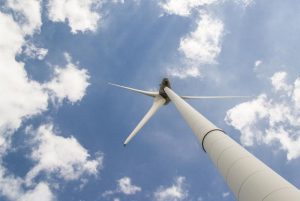 Wind turbines are getting bigger and bigger for three reasons: First, bigger blades with bigger rotor diameters capture more wind. Second, higher turbines catch rarified winds that blow stronger and longer. Third, advances in materials are able to handle severe weather. Now the “baddest of the bad” wind turbines is being developed by GE… the Haliade-X, 12 MW machine. Its blades are longer than a football field, fully 351 feet in length.
Wind turbines are getting bigger and bigger for three reasons: First, bigger blades with bigger rotor diameters capture more wind. Second, higher turbines catch rarified winds that blow stronger and longer. Third, advances in materials are able to handle severe weather. Now the “baddest of the bad” wind turbines is being developed by GE… the Haliade-X, 12 MW machine. Its blades are longer than a football field, fully 351 feet in length.
The average height of U.S. onshore wind turbines is 466 ft; the median is 499 feet, just under the 500- foot level that requires additional Federal Aviation Administration approvals. The only U.S. offshore installation, the Block Island Wind Farm, has wind turbines that stand 590 feet tall. They will be eclipsed by the Haliade-X which will stand 853 feet tall, nearly as tall as the Eiffel Tower (1,063). And in terms of capacity factor – the percentage of the time that a generating asset is generating — wind’s capacity factor is climbing steadily as turbines get larger. For machines built in 2014 and 2015, the capacity factor is now 42.5%. The Haliade-X is slated to have a capacity factor of 63%, nearly three times the typical capacity factor of turbines just five years ago.
EcoMotion Updates
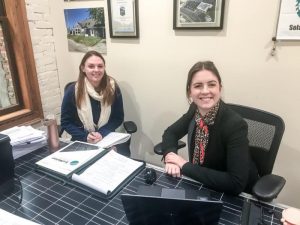
Michele and Emeline
Intern Update: EcoMotion is pleased to welcome Emeline Villien as our summer intern. Emeline hails from Annecy, France and is a student of international business from the University of Lyon. Some readers may remember last summer’s EcoNet story, “Finding Jean-Luc.” Emeline is Jean-Luc’s daughter. She’ll be focusing her time at EcoMotion developing infographics and supporting business development. Later this summer EcoMotion welcomes Anlon Zhu from Irvine. We also look forward to welcoming back star-intern Garren Bui, an engineering student from Cal Poly San Luis Obispo, for his second summer at EcoMotion.
Capital Group Companies: EcoMotion is working once again for Capital Group Companies, this time expanding the 1 MW solar system in Irvine with an additional 1.5 MW of capacity. The project involves six commercial rooftops plus a solar-port system on top of a parking structure. EcoMotion conducted the project feasibility and competitive solicitation. Borrego Solar has been selected for the installation.
Murrieta Valley Unified School District: For MVUSD, EcoMotion is managing a 20-campus exterior lighting retrofit. Funded by California’s Proposition 39, the retrofit will upgrade parking lot, courtyard, and other exterior lights while cutting energy use by 45% and annual costs by nearly $200,000 per year.
Chula Vista Elementary School District: EcoMotion completed a 48-site solar and storage feasibility analysis for CVESD. Our solar team has performed spatial analysis (for siting solar) as well as bill analysis and financial analysis for each site’s solar and storage potential. All 48 campus site visits were completed in early May.
Loyola Marymount University: EcoMotion has completed a Renewable Electricity Master Plan for Loyola Marymount. The planning process involved a broad look at both onsite and offsite generation options, with a focus on the existing solar systems there and the economics of potential solar system upgrades. EcoMotion prepared a report to LMU presenting four plausible scenarios for a) cutting costs, b) cutting carbon, and c) increasing resilience.
Kayne Anderson’s Renewable Energy Fund Luncheon: Ted Flanigan was the featured speaker at the luncheon launch of Kayne Anderson’s Renewable Energy Fund. Kayne Anderson Capital Advisors LP is known for its expertise in natural gas and its distribution. It is now offering its investors a new service… a fund for investments in renewables, notably utility-scale solar and wind. Ted presented “The Big Picture,” his talk highlighting the fantastic energy trends of our lifetimes… from the plummeting costs of solar and wind, and their commensurate rise in capacity, the rise of electric cars and now buses, and in the coming future… hybrid buildings!
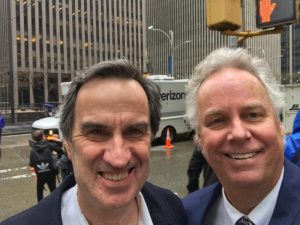
Ted and Phil
Visiting with Phil Roosevelt in New York: Oyster Bay, Long Island is known for oysters, Teddy Roosevelt and Billy Joel. It’s also my home town. In late April I had a chance to reconnect with my former classmate Phil Roosevelt, who’s now managing editor of Barron’s magazine. What a time we had – after 45 years – rapping and relating. Some friendships we found out just never die!
